Creating CMS 10.0-10.3 Site Instances
Prerequisites:
- Users must have site administrator permissions and access to the appropriate server.
- CMS 10.0
- 10.3 software must be installed. See Installing Ingeniux CMS 10.0 - 10.3 Platform for details.
After installing the Ingeniux CMS 10.0
To create a 10.0-10.3 CMS site instance:
- Within your server's file system, navigate to Ingeniux CMS 10.0 > Ingeniux CMS Site Wizard.
- In the New Site tab, provide a name identifying the new site
instance.
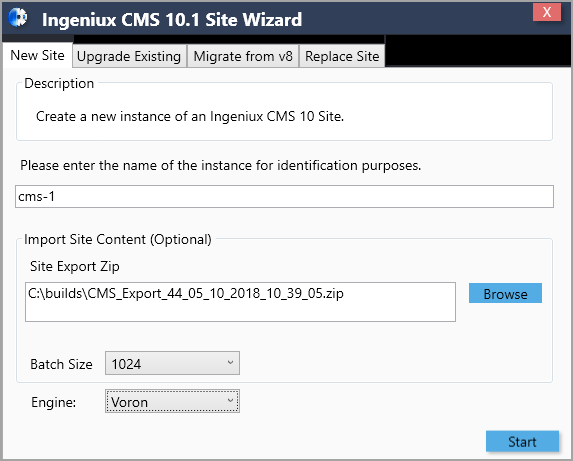
- Optional: If you want to set up a site from a site export:
- Click Browse.
- Select the site export .zip folder in File Explorer.
- Click Open. The path to the export zip file displays in the Site Export Zip field.
Version Notes: CMS 10.1+Setting up a new CMS site export disables replication profiles for all publishing targets, automatically. This feature prevents an accidental publish of test content to production DSS environments. Even though replication profiles are disabled, the replication profile settings are retained. - In the Batch Size drop-down list, select the maximum allowable size of the export zip. Servers with 8GB of RAM or less should use the default value of 1024. Servers with larger amounts of RAM can use a larger batch size for faster content import.
- In the Engine drop-down list, select Voron or
Esent.NoteIn preparation for future versions of RavenDB, Ingeniux CMS 10.1-10.3 defaults to the Voron storage engine for RavenDB instances.
- Click Start. The wizard opens.
- Click Next. The Select Instance Web Application Type dialog displays.
- Select either Web Site or Virtual
Directory.
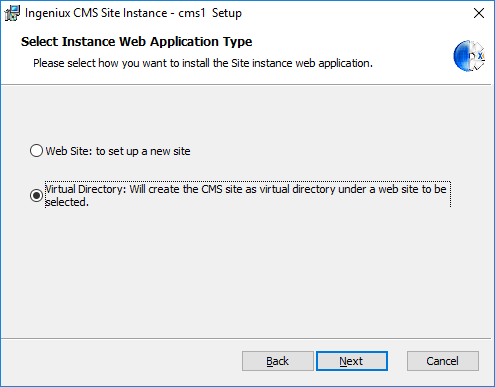
- If you want to set up a new website:
- Select the Web Site radio button.
- Click Next. The IIS Site Configuration screen displays.
- Configure the following values:
- IP Address
- Port Number
- Host Name
- Display Name (friendly name)
- If you want to set up the CMS site as a virtual
directory:
- Select the Virtual Directory radio button.
- Click Next. The IIS Virtual Directory Configuration screen displays.
- Choose the site instance under which to run the virtual site from the drop-down list.
- Enter the name of the virtual directory (or retain the auto-populated name).
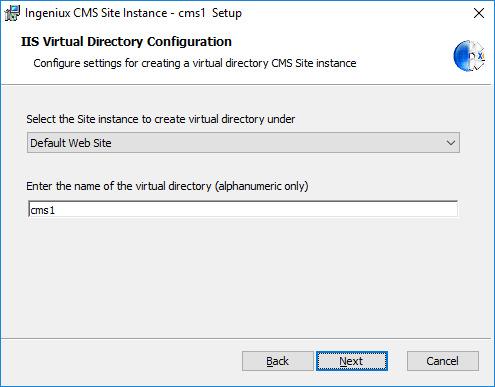
- If you want to set up a new website:
- Click Next. The Select User Provider Type dialog displays.
- Select either Ingeniux User Provider or Domain
Controller (LDAP or Active Directory).
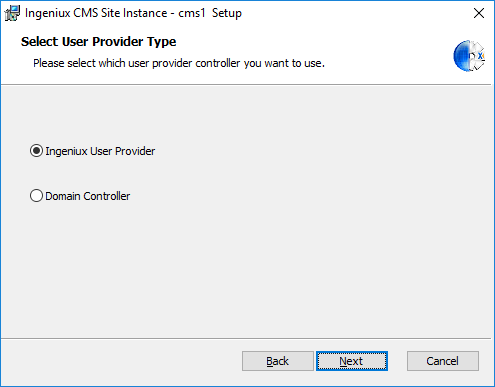 NoteThis step configures the administrative account credentials that must be used to log into the CMS first.
NoteThis step configures the administrative account credentials that must be used to log into the CMS first.- If you selected Ingeniux User Provider:
- Enter an Administrative User ID.
- Enter a password and then confirm your password in the respective
fields.
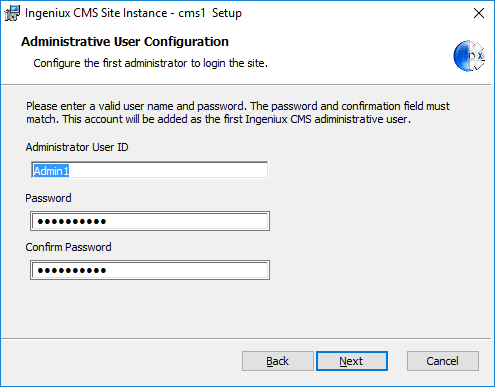
- If you selected Domain Controller:
- Enter a Domain Name in the field provided.
- Enter an Administrative ID.
- Enter an SMTP domain. This is the domain where users receive workflow
notifications from the CMS.
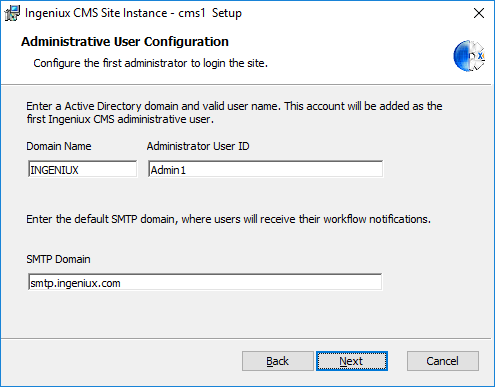
- Click Next. The Authentication Provider
Configuration screen displays.
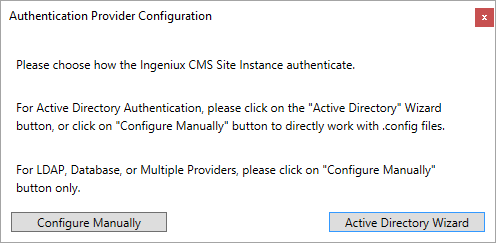
- To configure authentication manually, click Configure
Manually. The site instance installation continues;
however, you must edit the following configuration files in the
installation's site directory before logging in:
- local-appsettings.config
- local-connection-strings.config
- local-membership.config
- To configure Active Directory from the Wizard, click
Active Directory Wizard. The
Active Directory Authentication
Configuration dialog displays. Use the field examples
to help you configure Active Directory for your organization, or
click Use Defaults to set the configuration
files after installing the CMS site. Click
OK to close the wizard.
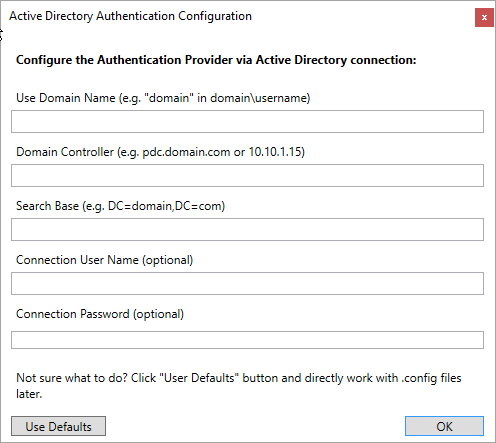
NoteRefer to Configure Authentication in Ingeniux CMS for configuration details. - To configure authentication manually, click Configure
Manually. The site instance installation continues;
however, you must edit the following configuration files in the
installation's site directory before logging in:
- If you selected Ingeniux User Provider:
- When you finish configuring the administrative account, click Next. The Custom Setup dialog displays.
- The final step in setting up a CMS site instance is to configure which features are
installed and where. For most sites, the default settings are adequate. Click
Next to begin the installation, unless you want to
customize how and where features are installed. To customize features in the Custom Setup dialog box:
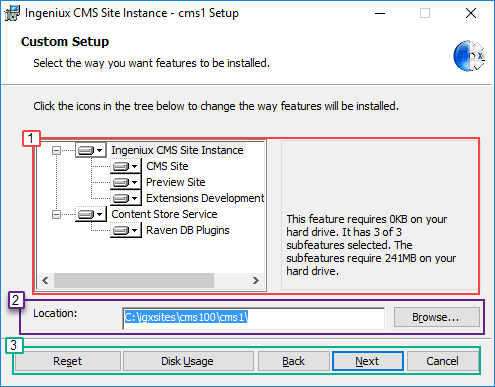
- Tree Area: Clicking any server icon in the tree opens a context menu
where you can decide to install a feature on a local hard drive or to run from
a network. You can also make entire features unavailable if they are not
necessary. NoteKeep in mind that in a standard CMS implementation, all features are required.
- Ingeniux CMS Site Instance:
- CMS Site: The site to be installed.
- Preview Site: A rendering of the DSS that users can see to preview their work.
- Extensions Development Package: Solution and project for developing hooks, apps, and plugins.
- Content Store Service:
- Raven DB Plugins: Ingeniux plugins for Raven DB to support custom indexing and other functionality.
- Ingeniux CMS Site Instance:
- Location: This field specifies the path where the CMS instance will be installed. You can change this location via the Browse button.
- Buttons: The following table describes each of the remaining buttons in
the Custom Setup dialog.
Button Description Reset Returns your feature options to their initial, default values. Disc Usage Clicking the Disc Usage button opens the Disc Space Requirements dialog. This dialog shows how much disc space your volumes have and how much disc space is required by the exported CMS. NoteA highlighted volume indicates that they do not have enough disc space.Back Returns to the previous dialog box. Next Advances to the next dialog box. Cancel Cancels the Ingeniux CMS site installation.
When you're finished customizing your site installation, click Next to begin the installation. - Tree Area: Clicking any server icon in the tree opens a context menu
where you can decide to install a feature on a local hard drive or to run from
a network. You can also make entire features unavailable if they are not
necessary.
- After the installation completes, click Finish to exit the
installer.NoteYou can uninstall a site instance through Add or remove programs in your server's System settings.ImportantBefore installing a new DSS instance, an administrator must first configure a publishing target within the new CMS instance and then execute a publish to the configured target. See Publishing Targets for details.
Next Steps: Once you have published to a target successfully, you can install a new DSS instance.
